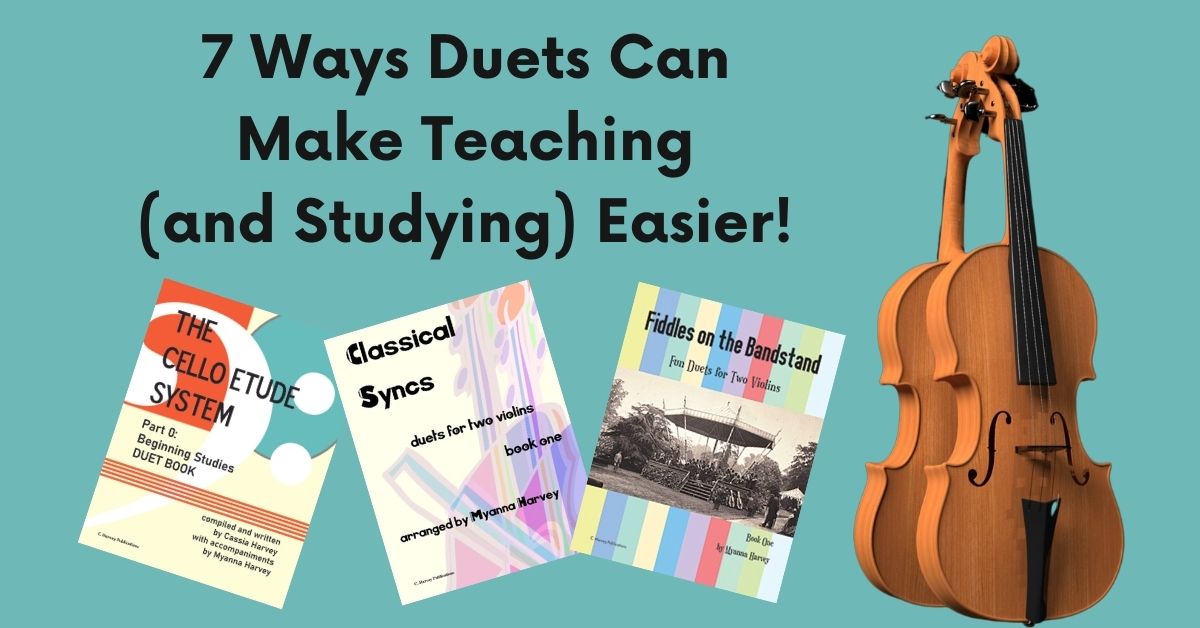There Had to be an Easier Way!
I had been teaching for a couple of years before I realized that there are a number of ways that duets can make teaching easier.
My teacher and I never played duets in our lessons when I was growing up. We stuck to hard-core exercise and etude books like Sevcik and Schradieck, Wohlfahrt and Kreutzer, and all the other great books that have been helping people improve at the violin for a hundred years.
As a result, my technique was great, but I could never count at all. Well into high school, rhythm remained a tantalizing mystery reserved for wind players and those who were naturally blessed with having “good rhythm”.
I learned all my repertoire rhythm by hearing it, including the ins and outs of orchestral music. Eventually a theory class forced me to actually learn how to make sense of what I saw on the page before I heard it, and the Great Mystery became just a math problem. Thank you Mr. Stephen Wilensky!
But when I started teaching, I needed a way to help my students count better that worked in the lessons. I started assigning duets in addition to technical studies, etudes, and solo repertoire and immediately saw my students improve!
Here are some of the benefits I’ve noticed from playing duets in the lessons with my own students over the years:
1. Duets Improve Rhythm!
- Duets are often written in score form, which gives your students a chance to see how the parts fit together and what each note is “worth.”
- Duets let the teacher establish and insist on a tempo that the student learns to follow. Students can feel pulse and phrasing from the teacher.
- Because duets don’t work unless the student counts correctly, they can hear why they need to count.
- Duets are usually the very first chamber music that students experience. Hearing another part at the same time that they are playing can be initially confusing but it is so important for students to get used to that!
2. Duets Help Sight-Reading!
Sight-reading was another big mystery to me as a kid.
Having students sight-read through duets that are a few levels below their current solo repertoire gives them hands-on guided experience in real-time playing.
They get weekly chances (with just a little bit of “in-lesson pressure”) to tackle the challenges in reading music and making sound from what they see on the page.
3. Duets Help Tone and Overall Sound.
When you play with your students, they subconsciously rise to the sound you are creating together.
If you use vibrato, they’ll use more.
If you are playing with a confident, beautiful tone, they’ll find themselves matching you. If you use longer bows, they will too.
Hearing you play alongside them will have a greater effect on their playing than all the explaining, exhorting, and general nagging I usually resort to.
4. Duet-playing Improves Morale.
- When I use duets that are shorter and easier than their concerto or sonata, it’s an easy win; my students can learn an assigned duet in a week or two and feel like they’re really succeeding at something. Solo repertoire takes longer to master and it can be discouraging to be in the middle of learning a long piece without shorter, less-intense music to bring some joy to the lessons.
- When we play together, the students sound much better than they do alone; it’s a tangible difference that they and their parents can hear right away.
5. Duet-playing in Recitals Helps Avoid Stage Fright.
Nervous performers (including some adult learners) can benefit immensely from performing with their teacher in a duet!
Duet performances give the student a safety-net and the sense that they aren’t alone up on stage!
6. Duets Help Build a Strong Student-Teacher Relationship.
Cassia and I both had some awesome and awe-inspiring teachers.
We never felt comfortable talking to them as if they were actual human beings.
Because of this, I am convinced that lessons were more stressful than they needed to be.
Duets help your students realize that it isn’t you against them; you’re in this together!
7. Duets Are Just Plain Fun!
- Trading rhythms…
- Taking turns on melody and harmony…
- Feeding off each other’s energy…
- Celebrating the social part of music…
- Playing music that sounds good, no matter what the level!















